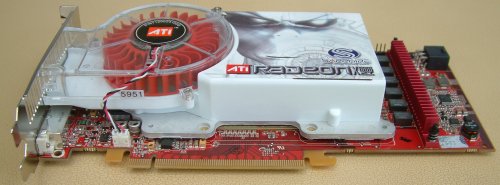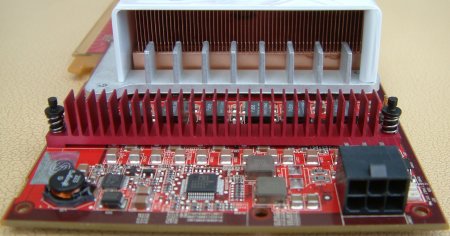SAPPHIRE RADEON X1800 XT 512MB examination
SAPPHIRE RADEON X1800 XT 512MBSAPPHIRE Technologies is one of the first companies to bring a retail RADEON X1800 XT 512MB card to the market. We took a look at the reference model just over a month ago and found it to be, on balance, the fastest video card of them all. ATI may only use 16 pixel pipelines and 8 vertex shaders in its design, but that is only half the story. Wholly impressive per-MHz shading power and a GPU architected to be the most efficient to date does just the job. A core running at a lofty 625MHz and memory at an effective 1500MHz doesn't hurt matters, either. We urge you to read our preview if you want to understand just why the R520 is as fast as it is, given its pipeline deficiency when compared to NVIDIA's GeForce 7800 GTX. Astute readers will gather that it actually out-features NVIDIA's G70, offering, for example, antialiasing in direct conjunction with high dynamic-range (HDR) lighting, although not too many titles implement it right now.
The RADEON X1800 XT 512MB sits at the top of ATI's current tree, one model up from the RADEON X1800 XL 256MB GPU that we took a look at recently, too. Getting the obvious out of the way, SAPPHIRE's 'XT uses double the framebuffer as regular 'XLs, and its asking price, of around £385, is £100-£120 or so more than your garden-variety X1800 XL. The real killer, though, as far as performance is concerned, is just how much faster the 'XT is in pure MHz terms. Its 625MHz core is 25% faster than the 'XL's 500MHz, and card memory is no less than 50% faster than the 1GHz specified on most X1800 XLs. From these basic stats we can surmise that in both fillrate- and shader-heavy games the SAPPHIRE RADEON X1800 XT 512MB card will be between 25-40% faster. Does that warrant the extra outlay? If you're an enthusiast, the answer has to be yes.

Now you can see why ATI and its partners have insisted on some heavy-duty cooling for all 'XTs. SAPPHIRE's taken the reference design and run with it, only adding a company-specific sticker on to the oversized cooler. One obvious physical difference between NVIDIA GeForce 7800 GTX and ATI's X1800 XT is in the latter's exclusive use of double-height cooling; Leadtek's card, on the previous page, is the exception rather than the rule, and most GTXs ship with low-profile cooling. We reckon it will be a short while until a card partner develops single-slot cooling that's potent enough to effectively cool the 625MHz core. Expect the first iterations of X1800 XT retail cards to look like SAPPHIRE's. The fan, incidentally, is the same as found on RADEON X850-based cards, and it rarely spins up at much more than a quiet hum. Prolonged GPU load and higher-than-normal ambient temperatures were the only occassions when the card's fan speed was automatically increased to levels that were immediately apparent.

A look at the side shows just how much effort has gone into cooling. The heatsink takes up three-quarters of the PCB and cools both core and RAM chips concurrently.

ATI doesn't distinguish between the PCBs based on its X1800 XL/XT cards; both are the same size and have the same general layout. The obvious departure is the cooling used to keep the 90nm-based cores cool. High-end and high-power cards can be immediately identified by the use of a 6-pin PCIe connector. This tells you that the PCIe x16 slot's ~75W doesn't provide nearly enough juice to keep the cards stable. It's hard to miss the copper fins in the above picture.

Rather than the fan push the hot air transferred from the GPU back inside a case, the situation here is just the reverse. The warm is pulled from the copper fins and then ducted and exhausted out of the back of the case, right through the upper cutouts on the double-height rear. Indeed, you can feel a steady stream of air being pushed out even if your hand is 6 inches behind the card. This cooling design, then, had to take up more than one slot just to function correctly.
For those who want an interesting read on the relative merits, or otherwise, about recent ATI and NVIDIA thermal control designs and limitations, have a read of this post made by our Paul Dutton on the HEXUS.community.
Common to the X1000 family are dual-link DVI interfaces that can each drive displays with resolutions up to 2560x1600. Nice, eh? As you will see in the following picture, the S-Video socket provides the conduit for VIVO.

The PCB layout could belong to any X1800 XL card, and only a careful look at memory timings would identify it as an 'XT sample. Speaking of which, SAPPHIRE uses 8 512MBit GDDR3 DRAM modules from Infineon, rated at no less than 1.2ns. That's a nominal, effective 1667MHz and the fastest DRAM we've seen thus far. Out of the box, the SAPPHIRE is clocked in at 1494MHz, suggesting that, even at this speed, there's still some headroom available. To the left of the GPU we see the ubiquitous Rage Theater 200 ASIC that provides basic VIVO functionality. The cooler, much in the vein of Leadtek's, weighs considerably more than the PCB, and SAPPHIRE adds in a full complement of thermal pads and thermal grease that makes decent contact with the GPU core.

The rear of the card simply highlights the central brace that firmly secures the cooler on to the PCB. It's common sense to stick with the reference design if you're one of the very first manufacturers to release a card based on a new SKU. SAPPHIRE has done exactly that here.









